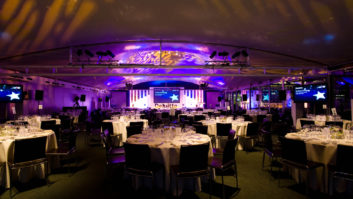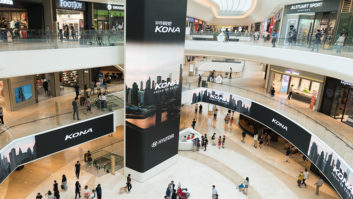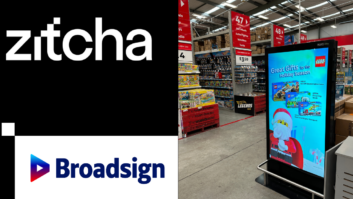Is retail currently a market segment you serve as part of an installation business? With the constant ups and downs inherent in consumer shopping tastes and the impact of eCommerce on physical storefronts, one probably can’t blame many AV providers from taking a hard pass. Past surveys by the Audiovisual and Integrated Experience Association (AVIXA), suggest that less than 40 per cent of providers regularly serve retail customers. Given the plight of the market now, with sales slumping due to a cautious consumer content to buy online, these percentages are likely even lower.
In fairness, according to AVIXA, retailer spending on pro AV products and services this year is forecasted to be down by 14 per cent in 2020 after a peak of $22.7 billion in 2019. As shoppers return to more pre-Covid activity growth in spending on technology also returns in 2021, expanding nearly six per cent on an annualised basis reaching $26.3 billion by 2025. For many expecting the full demise of traditional retail the declines this year are likely a further proof point of armageddon. The outlook for future growth however would raise a quizzical eyebrow. How can a market that is moving online drive growth for a service industry based on support for in-person businesses? The answer is short, even if somewhat overplayed – we (still) live in an ‘experience economy’.
What this means to retail is a need and desire for brands and stores to differentiate themselves from each other. They do so through narratives, or the story that their brand tells to and reflects their customers. Some of this story is told online via web page presence and social media coverage. Some can even be told via a simple product listing on a general eCommerce site. But more and more this story also needs to be told in person. Yes, to facilitate a tactile experience of trying on, feeling, or seeing a product, but also just to be in the presence of the brand. The delivery of this narrative experience is the rising purview of the storefront. And with it comes a fundamental shift in purpose away from transactional focus towards marketing objectives like awareness, loyalty, and affinity.
If you take a look at the retail landscape of today and the winners and losers in the battle for continued physical relevance, those stores focused on the lifestyle branding experience rather than the venues for perusing large inventories are perpetuating. Big box retail is fading out and smaller footprint boutiques are in, especially those baked by sophisticated eCommerce platforms to help complete the connection to a transaction in the ultimate end. This last point is particularly important in the pandemic normal where store traffic may be low, but sales can be attributed to specific locations through in-store pick-up or scheduled appointments.
Boiling this experience down reveals the opportunities for creative AV professionals. Beyond the back-end systems for online retail and distribution, there is a tremendous amount of technology investment and deployment at the point of interaction (rather than what we might have called the point of sale). This includes both one-way and interactive digital signage for informing and engaging shoppers, along with light, sound, and other environmental effects – the wheelhouse of the audiovisual professional.
- EMEA pro AV market to fall nine per cent in 2020
- AVIXA: hardest hit markets will see strongest growth in 2021
- Americas pro AV market to drop to $86 billion in 2020
Digital signage and displays is one of the flagship opportunities for AV professionals in retail. Despite the declines in retail spending in 2020, the market remains the single largest purchaser of displays. AVIXA estimates show $5.9 billion worth of displays will be purchased globally through the pro AV channel by retailers this year. As recovery takes place this grows to $7.3 billion in 2021.
Fundamentally, displays in retail seek to solve a fundamental objective – helping shoppers locate the right product for their needs. Past AVIXA research among shoppers revealed that overall satisfaction with the retail experience is most correlated with solving this primary objective. Aligning technology integration with support of this objective, rather than just existing for its own sake, is crucial to success.
Examples of effective use are becoming more prevalent. At a basic level, more displayers are finding their way into malls just to act as wayfinding devices. Proliferation now even extends all the way to the product displays themselves as network connected fact and pricing tags. Other examples include interactive displays to allow a shopper to browse available inventory or virtually try-on a product. This then also serves as a data capture mechanism for determining interest levels, orders, and demographics for marketing purposes, further empowering retailers.
Displays are just one part of the picture, though they are the easiest for shoppers to recall given their literal ‘in-your-face’ presence and higher price points for the top end products. Other ambient technologies are in the mix as well, such as lighting solutions and audio for enveloping the shopper in on-brand music or sound selections. A whole new area of research has emerged about the usage of audio to create specific emotional and personal experiences to convey specific branded experiences. And new beamforming audio technologies allow for these audio experiences to be even more targeted in stores, creating a personalisation even down to the specific point of interaction mentioned before.
Each of the technologies listed above help support the forecast of growth for retail spending on pro AV for the future as storefronts battle against obsolescence through diversification. Certainly, stores face challenges in the near term as the effects of the pandemic continue to simmer in many economies, but the long-range is hopeful as retailers position themselves to emerge from the ashes stronger than ever. And perhaps even more now than in the past, technology will play a crucial role in this adaptation.







